WOMEN'S 70s FASHION
Flared jeans, bell bottoms, and bold casual outfits - yep, we're talking about the 1970s when fashion was all about talent, creativity, and art inspired for the greater good. Unlike today's talent deficit fashion era, the 1970s were big on hippie, disco, and boho outfits, taking inspo from outcasts. If you want to create a look featuring women's 70 s fashion, complete your outfit with the following fashion trends.
Early Seventies
By the end of the sixties, the fashion industry was greatly inspired by the hippie and bohemian lifestyle. Peasant and folk-embroidered outfits took the world by storm, emphasizing chunky hand-made accessories. The psychedelic color palette and trippy aesthetic art ruled the runway with bold makeup.
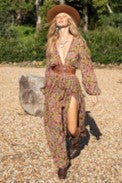
Source: Pinterest - Chasing Unicorns
Maxi Boho Dresses
One of the most popular outfits of the 1970s is the maxi boho dress. It features a long loose fit with slits, fringes, or pleats. Accessories like bohemian-inspired boots and knotted head wraps compliment the outfit. You can also pair the look with Afghan vintage jewelry, as it highlights bronze and silver coins with rustic detailing. The go-to hairstyle with this outfit for most people used to be braided hair or loose wavy hair with a stylish boho hat.
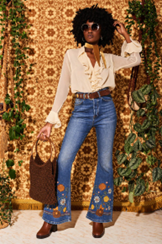
Source: Pinterest - the hippie shake
Flared Jeans
Inspired by the US Navy, the flared pants or bell bottoms seeped their way into the pop-rock culture of the 1970s. Whether regular or ripped, the flared jeans trend is still highly appreciated as one of the best pants to buy. The USP of these pants back in the seventies was how they accentuated the body's natural curves, giving the illusion of long legs. Ankle boots or block heels used to be worn to top off the entire look.
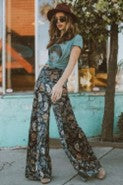
Source: Pinterest - erecdeseinesaintenis
Hippie Fashion
Fringes and patchwork play a significant role in creating hippie outfits, which were the main highlight of the seventies. The clothing style features unconventional paisley printed dresses with bright colors. Most women wore dresses to keep it feminine, while some preferred a casual outfit with a button-down and bell bottoms.
Mid Seventies
By the mid-1970s, gender equality and women's power rose in the spotlight, paving the way for women's business wear. Waist-cinching dresses and corsets were a big no for women who opted for tailored blazers and straight silhouettes.
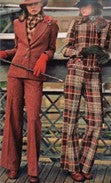
Source: Pinterest - SecondhandNew
Pantsuits
Pantsuits and jumpsuits were the main clothes that contributed to the feminist era, with their broad shoulders and straight silhouette. Unlike regular women's wear, these did not fit perfectly, diverting the focus off of women's curves and offering a more dominating personality. Suede pant suits in light colors like pastel blue and pink balanced the look, adding a differential factor to the clothes. Though most people, especially men, were against this fashion trend, it became permanent with time and now symbolizes the outfits of boss ladies.

Source: Pinterest - flickr
Knitted Wear
After the fall of hippie wear, the knitted fashion attention of the elite and fashion divas of that time. This fashion sense was highly appreciated by the sophisticated class of society as well since the least to no controversial element. The knitted blazers or sweater has an androgynous silhouette that goes well with skirts or pants. During the hype of knitwear for women, crochet also came under the spotlight and became a fashion staple for many.
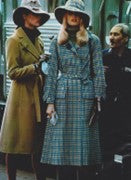
Source: Pinterest - bittersweetcolours
Midi Skirts
Contrary to the times when skirts were ankle-length, the midi skirt gained popularity as controversial clothes that exposed skin. However, when midi skirts reached the US in 1970, they instantly got famous due to cultural differences. The midi skirt was cute, comfortable, and, most importantly, a fashion statement for elite women. It caught attention, especially when worn gracefully with long leather boots or a hat. Some designers added their own touch to the outfit by mixing it with denim, though the trend didn't hit hard.
Late Seventies
The world bid farewell to the seventies by welcoming disco fashion, which was approved by all party freaks. This style was a mixture of hippie fashion with formal wear as it has big accentuated platform heels and heavyset accessories. Though this fashion style didn't last for even a decade, it helped the industry grow in terms of creativity.
Rock Style
The musical era of Elvis Presley influences the rock style or punk fashion of the 1970s. Everything was inspired by the pop icon, from open neck-deep collar button-downs to bell pants. The rockstar theme followed dramatic ruffles incorporated in casual everyday clothing like colorful shirts with a fi-chu. Chunky boots were worn by women to add up to their height, as it was a beauty standard of the time. People also added some leather garments like a jacket as the cherry on top.
Source: Pinterest - vintagedancer
Jersey Wrap Dresses
Though dresses were not much in fashion by that time, the jersey wrap dress was a hit that led women back to the concept of femininity. The vintage stripe-printed dress had a defined bodice that wrapped above your waist, offering an empire waistline. This dress was unlike other dresses as it cinched near the bust, giving you the illusion of an hourglass figure. Pockets were another highlight of this outfit as they offered storage. Excluding the pockets, the look is still a staple for most women as a classic, even after decades.

Source: Pinterest - struts
Sequins and Spandex
Disco fashion was at its peak during the late 1970s which was a time of glitz, glamor, and bold cuts. The clothing style covered vibrant colors with bold prints and extra-fitting. Funky fabrics like spandex, faux leather and crochet were mixed with disco-themed colors like silver, black, and red. Tube tops, sequined shirts, spandex pants, and high-slit mini skirts were the main highlight trends of the late seventies.
Conclusion
The 1970s was a revolutionary era for fashion, not just for women but for men as well. It modified the vintage clothing from earlier decades, taking inspiration from societal and political turnovers. Regardless of the many controversial elements in 1970s fashion, it was a game changer for the fashion industry from the revenue aspect. It has time-to-time make a comeback, and who knows what the future fashion has in store for us.
